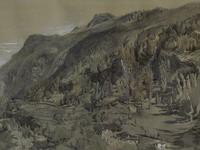John Ruskin and the Geographical Imagination
Denis Cosgrove selects works from Ruskin’s Teaching Collection and reveals a poetry of landscape that inspired geographical learning a century ago.

In his earliest published writing, The Poetry of Architecture (1837-38), Ruskin sought to connect the 'situation and climate' of natural landscapes to the cultural characteristics of those who worked and lived in them, a remarkably similar project to that of late 19th century geographers such as Paul Vidal de la Blache for whom the cultural landscape was ‘a medal struck in the likeness of a people.' Over time Ruskin’s taste for the picturesque harmony of such scenes gave way to concern for the actual conditions of those who lived in picturesque squalor and despair at the destruction of lives and landscapes by modernisation.
'The notablest thing in the town of Fribourg is that all its walls have got flexible spines, and creep up and down the precipices more in the manner of cats than walls.' (6:46) One of a group of educational images intended to illustrate 'what German and Swiss life were in their happiest associations with landscape about the beginning of this century.' (21:133)
Another example of what Ruskin saw as a human structure unconsciously but perfectly suited in form and appearance to natural forces.

Lateral View of the Façade of the Destroyed Church of San Michele at Lucca, as it appeared in 1845
Ruskin’s reputation as a precursor of contemporary landscape conservation derives from his early polemics on the crude restoration of Italian architecture – the stimulus to his Stones of Venice. 'I sit in the open warm afternoon air, drawing the rich ornaments on the façade of San Michele.' (Letter to his father, 6 May 1845) 'It was destroyed by having its façade, one of the most precious twelfth-century works in Italy, thrown down and rebuilt with modern imitative carving and the heads of the King of Sardinia and Count Cavour instead of its Lombardic ones.' (21:123)
References
All references to Ruskin's writings are taken from The Works of Ruskin, Library Edition, 39 volumes, edited by E.T. Cook and Alexander Wedderburn, George Allen, London, 1903-1912 and given by volume number and page.






